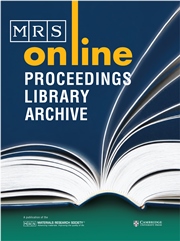No CrossRef data available.
Article contents
Temperature Dependent Thermopower and Resistance Measurements of CNT-MgB2 Composites
Published online by Cambridge University Press: 12 April 2012
Abstract
The temperature dependent resistance R(T) and thermopower S(T) of sintered single wall carbon nanotubes (SWCNT) and magnesium diboride (MgB2) composites containing 5wt%, 10wt%, and 15wt% of SWCNTs have been measured and compared to their pure counterparts. The thermopower of both MgB2 (in the normal state) and SWCNT remain positive over the entire temperature range (10K to 300K) with room temperature values being ∼ 8μV/K and 57μV/K, respectively. The thermopower of the sintered composites decreased with decreasing temperature and switched from positive to negative near 70K. The superconducting critical temperature (Tc) of the samples ranges from 38K-41K. The room-temperature resistance ratio (RRR) is seen to depend on the sample composition. The temperature width (ΔT) is observed to increase with increasing SWCNT concentration. The normal state resistance data were fitted with the generalized Block-Grüneisen function obtaining Debye temperature of ∼ 900K.
- Type
- Research Article
- Information
- MRS Online Proceedings Library (OPL) , Volume 1407: Symposium AA – Carbon Nanotubes, Graphene and Related Nanostructures , 2012 , mrsf11-1407-aa10-38
- Copyright
- Copyright © Materials Research Society 2012




